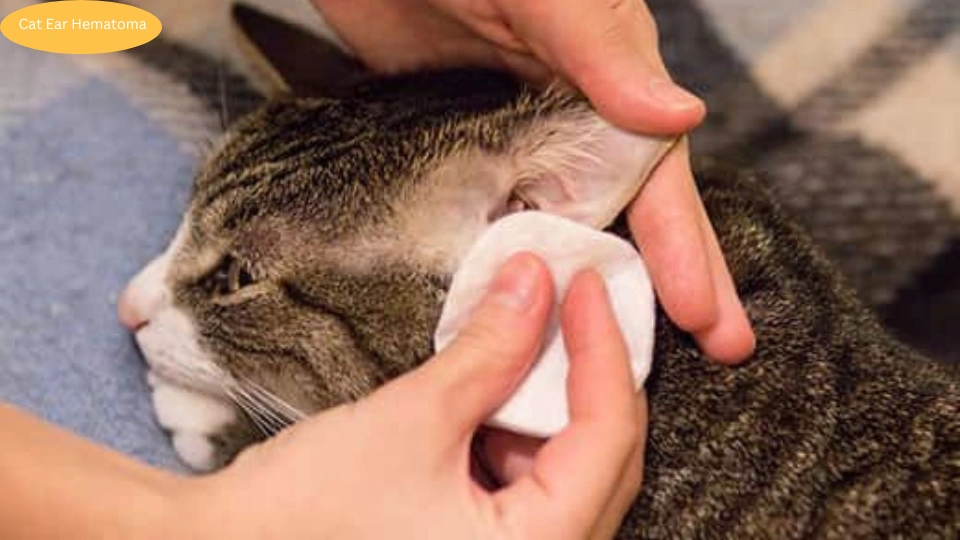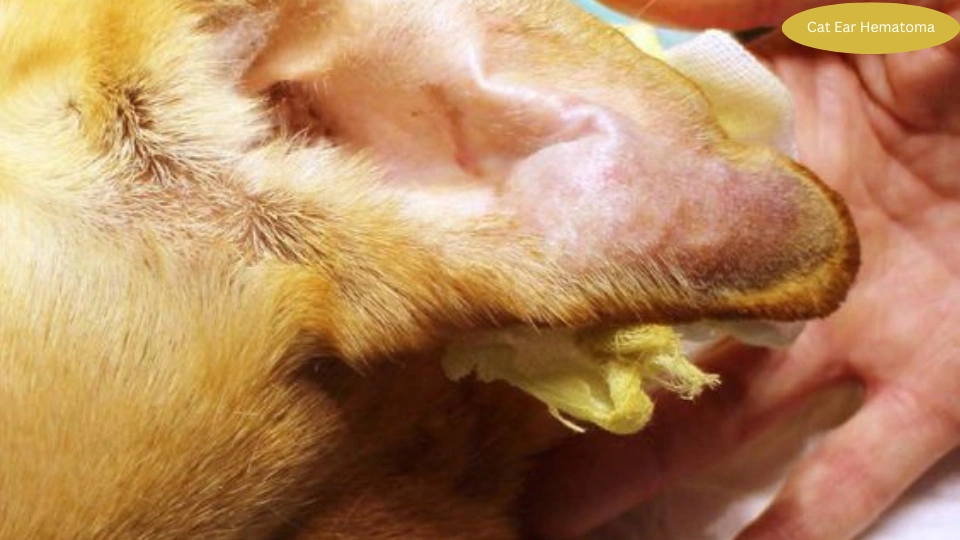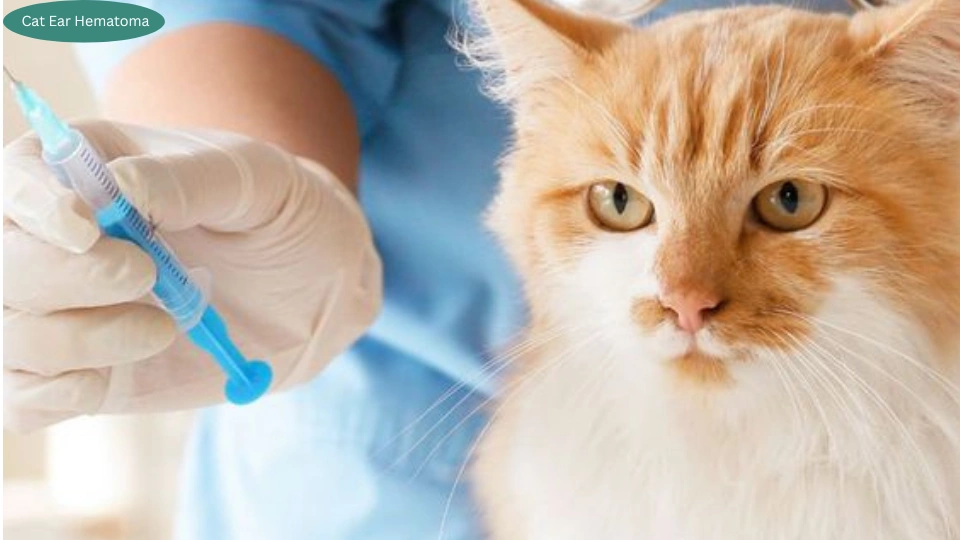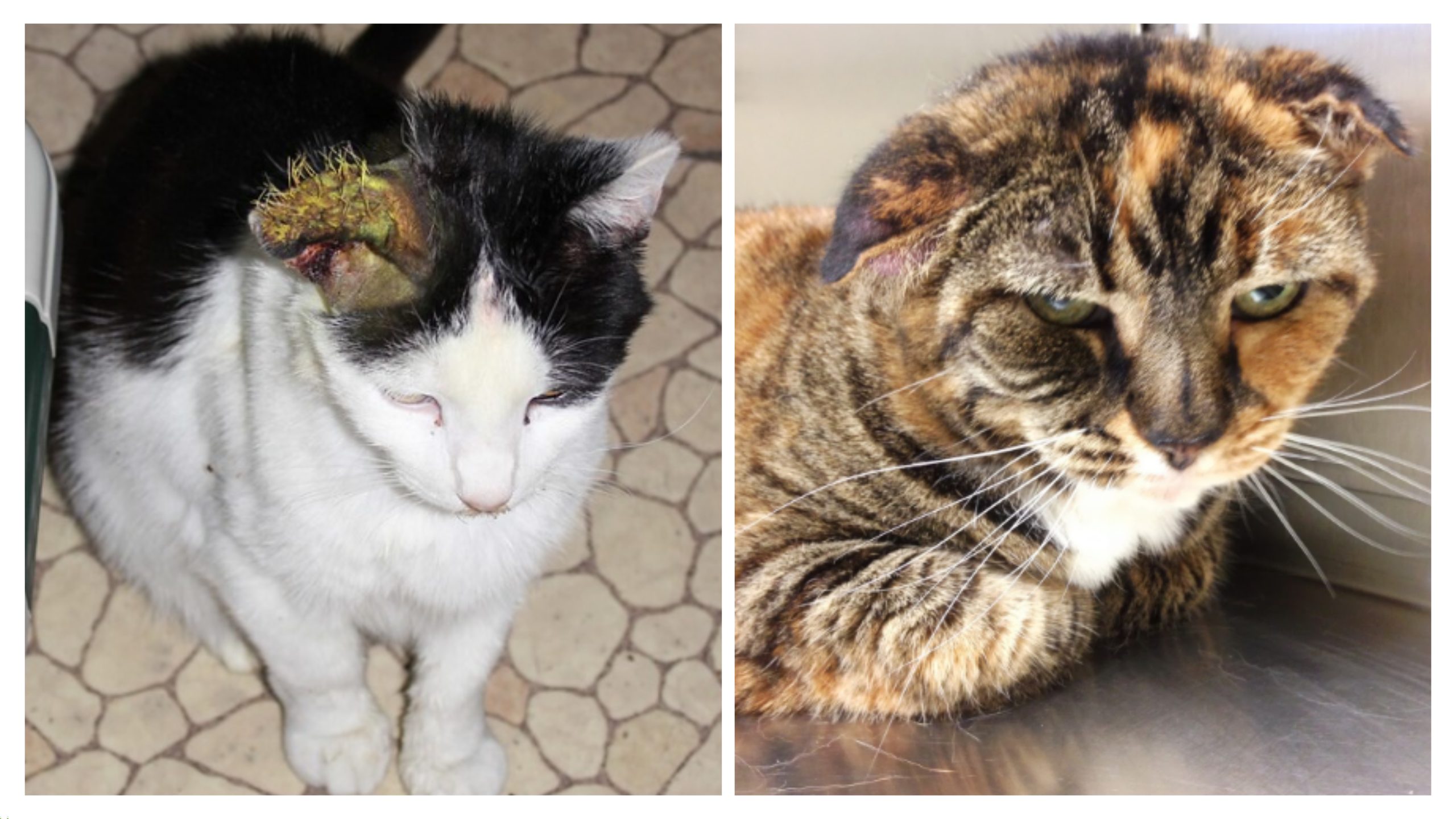Last Updated on February 11, 2024 by Aftab Tariq
Cat Ear Hematoma occurs when there is a localized accumulation of blood in the earflap or cartilage. This condition results in a warm and soft swelling, often caused by the cat’s self-induced injury, such as continuous scratching or head shaking.
A cat ear hematoma bleeding specifically refers to the occurrence of bleeding in this swollen area, where blood accumulates due to the cat’s persistent scratching or head shaking.
Besides these behaviors, underlying health problems can also contribute to the development of ear hematomas in cats. Recognizing Cat ear hematoma symptoms is crucial in identifying signs of this issue, where a warm and soft swelling becomes noticeable due to the localized accumulation of blood in the earflap or cartilage.
This ailment causes the cat’s ears to droop, emphasizing the necessity of reaching out to a veterinarian promptly for an early diagnosis and appropriate treatment of the swelling.

What Exactly is Cat Ear Hematoma?
When a blood vessel ruptures in a cat’s ear, it leads to the formation of a pocket of blood in the ear flap, a condition commonly known as “Cat Ear Hematoma.”
This occurrence is often triggered by underlying health issues such as ear infections or irritation, prompting the cat to scratch or shake its head, resulting in injury or swelling. In rare cases, Cat Ear Hematomas can also be caused by traumatic incidents or other injuries.
While not a frequent issue, addressing the root cause of ear irritation is crucial, and surgery is typically required to drain the accumulated swelling in Cat Ear Hematomas.
If you’re curious about ear hematoma in cats, you can find valuable insights by searching for “pictures of ear hematoma in cats.”
These images, commonly referred to as “cat ear hematoma pictures,” offer a visual guide to understanding the condition and can assist in recognizing and addressing ear hematomas in your feline companions.
Will A Cat Ear Hematoma Go Away On Its Own?
Is a cat ear hematoma an emergency? Even though a hematoma isn’t an emergency, it’s essential to take care of it as soon as possible. Responding quickly will reduce scarring and relieve the discomfort caused by pressure and a heavy ear flap.
If your cat has small, painless ear hematomas, the vet may not suggest any special treatment. Usually, these hematomas heal on their own. But if there’s painful swelling, it’s important to get prompt medical help.
Is there any home remedies to heal a cat hematoma? It’s not recommended to try home remedies for ear hematomas, as they are often painful and may indicate an underlying ear issue that requires proper diagnosis and treatment. If you suspect your cat has a hematoma, it’s essential to seek veterinary care for professional and effective treatment.
Cat Ear Hematoma Causes

The outer ear has two layers of skin separated by a layer of cartilage, with blood vessels just underneath the skin. When your cat’s ear canal is irritated, it might scratch or shake its head. If the shaking is too intense, it can break one or more blood vessels, causing bleeding between the ear cartilage and the inner skin surface.
Various other factors can contribute to the occurrence of ear hematomas in cats, such as:
- Inflammation within the ear
- Allergic reactions affecting the ear
- Cat Ear infection
- Increased fragility of capillaries, as observed in conditions like Cushing’s disease
- Diseases associated with the immune system
- Presence of parasites
- Sudden traumas, such as bite wounds or blunt impacts
If left untreated, ear hematomas in cats can endure.
Addressing cat ear mites promptly is crucial for your cat’s comfort. If you notice excessive scratching or head shaking, consult your vet. Specialized ear drops or medications can effectively eliminate these microscopic pests. Regular ear cleaning helps prevent their return, ensuring your cat stays happy and healthy.
How Do Vets Diagnose Ear Hematoma in Cats?
Detecting ear hematoma is quite straightforward, but vets run specific tests to confirm it. They carefully examine your cat’s ear to find any underlying issues causing irritation.
Tests include:
Systemic testing:
Looks into potential root causes using tests like ear swabs (microscopic examination for bacteria, yeast, or mites), allergy tests, or endocrine tests.
Cytology or fine needle aspirate (FNA):
This involves collecting a small sample for examination.
Managing an aural hematoma in cats involves two main approaches: using a needle for aspirating blood and clots from the ear flap or choosing surgical drainage. Opting for surgery is preferable, as using a needle often provides only a temporary solution in the aural hematoma cat treatment.
Cat Ear Hematoma Treatment
Your vet will choose the best treatment for your cat, and in cases of cat ear hematoma surgery, a precise procedure is often recommended.
This involves making a careful incision under anesthesia, draining accumulated blood from the ear flap, and then meticulously suturing the layers for an effective and lasting solution.
This surgical intervention not only directly addresses the hematoma but also deals with any underlying issues to prevent recurrence.
Draining Swelling through Surgery:
Usually, vets use a syringe or needle to reduce swelling, but it often comes back. In those cases, your cat may need surgery.
The vet opens the earflap, removes collected blood, and makes a hole for drainage to prevent it from happening again. The ear flap is stitched flat to help it heal without filling up.
Getting the Blood Out: To remove the blood from the pinna, small cuts are made at each end of the hematoma. A tube might be placed through the hematoma and attached to the ear for ongoing drainage. Another option is to cut and open the skin over the hematoma.
Keeping Things Stable: To prevent more damage, the pinna is stabilized. This can be done by applying a bandage directly to the ear or securing the ear against the head with a bandage. It’s important to avoid shaking the ear after stitching to prevent further harm.
Treatment of Primary Cause: If the vet figures out what’s causing the ear problem, they can give the right treatment. This might include oral antibiotics for an ear infection, topical meds for mites, or anti-itch medicine for skin issues.
Clearing the Space: Sutures (stitches) are used to eliminate the space where the blood gathered. These stitches go through the entire ear flap, securing both layers of skin to the cartilage.
Potential Risks of Ignoring Hematoma: Not treating hematoma could lead to a deformed ear, looking like a “cauliflower” due to thick skin. There are risks like the ear flap dying off and the hematoma coming back.
What is the cost of “cat ear hematoma treatment cost? The cost of treating ear hematoma in cats may vary, with general practitioners charging less than $1,000, while specialists may charge two to three times that amount, depending on the location.
What Care is Required After the Initial Treatment?
Your vet might remove drainage tubes or bandages between 3 to 14 days after the surgery. There could be one or more openings from the drain or cut, and these will heal on their own through scar tissue.
Sutures might be taken out after two weeks if the ear is fully healed. In tougher cases, some or all of the sutures may stay in place for an extra two weeks.
Monitoring “cat ear hematoma after surgery” is crucial for a smooth recovery, ensuring prompt attention to any potential complications. Veterinary follow-up and proper care play vital roles in successfully managing post-operative feline ear hematomas.
If you notice any discharge from the surgery sites before they close, simply clean it with mild soap. If there was an infection, it’s important to check the ear canal again to make sure it’s fully cleared. Otherwise, there’s a chance another hematoma may occur.
During cat ear hematoma surgery, the surgeon uses stitches to secure the ear cartilage all over. The cat ear hematoma surgery cost can differ; if done by a general practitioner, it might be under $1,000. Yet, a specialist could charge two to three times that amount, depending on the location.
What Happens if You Don’t Take Care of an Ear Hematoma?
If you don’t take care of an ear hematoma, it might slowly go away, but the swelling can damage the nearby ear tissues, making the ear look distorted like cauliflower and possibly blocking the ear canal.
The longer a cat ear hematoma left untreated, the higher the chance of lasting damage and disfigurement. Ear hematomas are painful, so it’s important to treat them quickly for the well-being of the affected cat.
Caring for a Cat with Ear Hematoma

To keep your cat healthy after surgery and prevent swelling from coming back, follow these simple steps at home:
- Clean your cat’s ear as per the vet’s instructions.
- Keep an eye on your cat’s recovery—watch for pain, swelling, and redness. Call your vet if there’s too much bleeding.
- Make sure your cat wears the cone provided by the vet until told otherwise.
- Give your cat all the prescribed medications on time.
- Most cats fully recover from ear hematomas within one to two weeks.
Sources
Cornell University College of Veterinary Medicine
American College of Veterinary Surgeons
The Canadian Veterinary Medical Association
I am a dedicated content writer with more than five years of experience, particularly skilled in the art of storytelling. My writing journey commenced during my college years, where I pursued journalism and unearthed my talent for creating captivating narratives.


